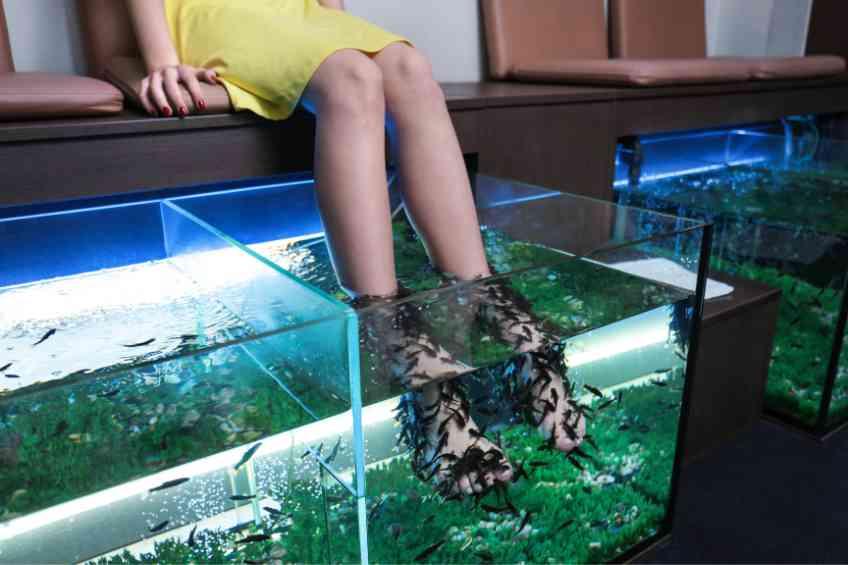By Barbara Krooss –
Short of images like the opening scene from the movie Jaws, people who instead have willingly opted to have fish nibbling on their toes report it’s a unique and generally positive sensation. Great, maybe it’s also fun and a great cocktail party conversation. Kardashians even got in on the growing fad a few years back. But is it safe and effective? Not always. It’s not great for the fish either, according to some reports.
One thing is for sure: the practice isn’t new. In the deep blue, scuba divers visit tropical “cleaning stations,” magical places on coral reefs, where tiny cleaner fish fearlessly remove dead skin, parasites infected tissue from the skin, mouths and gill chambers of larger “client fish” that would eat them. Patient divers can join in for a manicure or—sans fins—a pedicure. Those with good breath-holding skills can even get their teeth cleaned by an unusual dental hygienist. There are pictures to prove it.
Conversely, by the early 1900s, commercial fish pedicures were already underway in Turkey thanks to some earlier research from biologist Johann Jakob Heckel, who noticed fish nibbling dead skin from bather’s feet in local reservoirs. Why Heckel was watching is uncertain, but the fish pedicures soon spread from Turkey to Greece, Japan and some Middle Eastern countries. Today, it is widely available in the U.S.
The modern process involves having a client’s feet washed and disinfected and then plunked into the water filled with hundreds of 1- to 2-inch fish. These little guys exfoliate the dead skin from heels, soles and toes by “kissing” or sucking like tiny vacuum cleaners. Garra Rufa, freshwater carp from the Middle East and Southeast Asia, are most often used in part because they’re toothless.
There is no precise handle on the market size because the manicurists involved don’t have to be registered or licensed. Beyond this, the practice is illegal in at least 15 U.S. states, Mexico and parts of Canada and Europe. These restrictions have resulted in a growing clandestine business, which makes measuring the size of the market almost impossible.
Nonetheless, for those interested, costs for a 15- to 30-minute session in the U.S. usually runs from $40 to $100. These costs don’t include post-nibble pedicure clean-ups or other services.
The dangerous rub or perhaps bite comes in because even where it is allowed, the potential for health hazards can run rampant.
Pre-treatment sanitizing of feet and tanks is a minimum for maintaining health standards. Nonetheless, even with the minimum, a recent study out of Europe notes that fish pedicures pose health and environmental risks.
The Turkish government, for example, has identified the Garra Rufa as a protected species because of their overuse by spas. It has led to demand for Cyprinion Macrostomus or Chin Chin fish. Sure, they look like Garra Rufa but don’t hold up as well to the rigors of the job. Plus, unlike Garra Rufa, Chin Chin fish have teeth and know how to use them.
Even the toothless Garra Rufais is not without faults. Dr. Shilpi Khetarpal, a dermatologist, noted that in one case, a Garra Rufa fish pedicure disrupted nail plate growth, damaging its stem cells, which later caused a client’s toenails to fall out.
The Centers for Disease Control and Prevention also warns of the dangers of fish pedicures noting that it is challenging to maintain hygienic conditions in human-made fish spas. One problem is that several patrons get the same fish. Since there’s no way to disinfect the fish without killing them, they can transmit bacteria like Streptococcus Agalactaie group B and cause mycoacteriosis, pneumonia and bone, joint and bloodstream infections. The practice can lead to deaths, which is confirmed. Individuals with diabetes or compromised immune systems may be a particular risk.
Safety aside, those looking to put their best foot forward are interested in any potential benefits. Fish pedicures, admittedly, may deliver some. Cuticles are neater, and feet are noticeably softer, smoother and relatively callus-free after a treatment. But a spa technician can neaten things unable a nibbling.
The process may also provide a memorable sensory experience and improve foot health. Research published by S. Ozçelik in the Journal of Dermatology reports that three weeks of twice-daily fish pedicures significantly improved psoriasis.
Taking a foot dip still has its risks, however.













